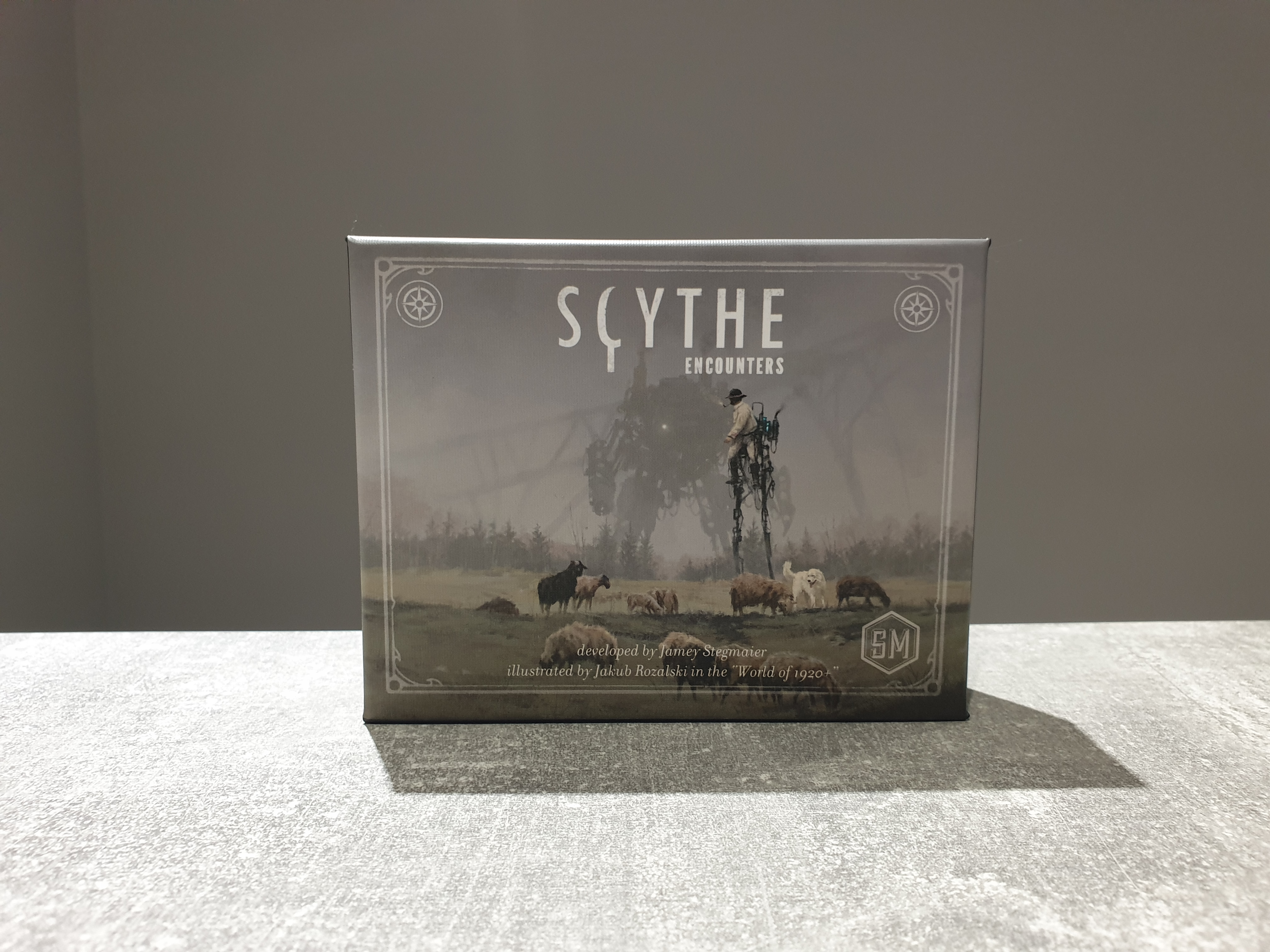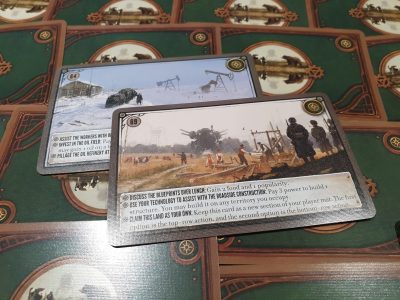Encounters is a micro expansion for Stonemaier Games’ grand area control board game Scythe. Released at the tail end of 2018 this is a collection of 32 brand new encounter cards, aiming to innovate on the original deck of encounters. The cards were crafted by Jamey Stegmaier, based upon user submitted ideas. However, do they match up against the original set? Let’s find out!
In case anyone reading has not heard of Scythe, you can check out our review here. Put short, Scythe is a board game, which looks like it’ll see constant fighting with resources and mechs on the battlefield. However, it has more of a cold war vibe, with players often staying away from each other attempting to build up their grasp on the hexagonal territories. Encounters are events that occur when players get their character pieces to placed encounter tokens.
The original encounter set has one set style. There are always three options to read aloud, each coming with a reward. Firstly, there is the “be nice” choice, where no matter the encounter the player helps out and gains a little reward. Secondly, there is a type of trade. This is where players can pay for a slightly better reward. Finally, in the original encounter set there is always a (politely put…) “be horrible” option. This sees players lose popularity in return for a great benefit.
The vibe of the new set is rather different, to the extent it took take a few games of Scythe playing with only the new encounters to grasp how powerful they can be. As Stonemaier Games’ suggested when this set was announced, these encounters have innovated on the original deck, bringing in a number of new elements. While gaining oil, paying popularity and building structures are still all possible, new actions and abilities have been introduced.
The most extreme, in terms of difference, involve a unique way to score at the end of the game, depending on the terrain types of hexes you control. Not only is this one of the new type of cards where players do not read the options aloud, they also keep hold of the encounter card instead of simple completing one option and discarding it. Other examples of the changes to expect from this cards set include a different type of interaction with game tokens to removing you action pawn from your player board, akin to My Little Scythe’s rejuvenation mechanic.
Keeping hold of encounter cards instantly tells the other players around the table what sort of card it is but there are enough included to not give away what ability they grant. This feels somewhat similar to the Japanese faction’s traps. Players instantly know of a trap but not what type of damage it can inflict. It is a nice trade off of information, and kind of adds to the cold war style tension – therefore surprisingly fits well with Scythe.
The artwork that adorns these encounter cards has once again been done by artist Jakub Rozalski, so the style perfectly fits his alternate 1920s setting – thus matches the rest of Scythe. The way the majority of the cards have artwork that directly relates to the choices on the card is phenomenal. A fair few feature airships which is a bit odd when playing without them. Nevertheless, the biggest shame is that for much of the game this gorgeous artwork sits face down waiting for the cards to be picked up!
For the most part the encounter options sound thematic and, as mentioned, somewhat match up with the artwork of the cards. There is one almost glaring exception to this, encounter card 61. Whilst the actual action of paying 2 popularity for 2 metal and an objective cards makes somewhat sense from the image of an airship, the text of “Punch the airship in the face” feels to brash. From the rest of the cards, especially the original encounter deck, this just sounds out of place. A tiny problem but one I am surprised got past Jamey Stegmaier’s extremely high standards.
This deck has been designed to perfectly shuffle with the original, vastly decreasing the probability of seeing the same encounters coming out in a handful of games. The sizing and backs are, as expected, identical so there is no worry about being able to tell them apart when face down. This being said, you can tell the cards apart from the rest as they are numbered 43 to 74.
Despite the new deck of encounters offering a new wave of replayability to the game, I am still not convinced enough to leave the deck shuffled into the base game encounter deck. The vibes of the two decks are so different that while I’ll keep the extra deck, I’ll leave it up to a vote pre-game on which set to use. In reality the cards of the base set are situational, with an encounter offering a mech for popularity requiring the player to not have built all 4 mechs and have some popularity. This encounter set feels more situational though, due to cards that activate at specific times. If you are starting to feel encounters of the base game as getting stale this is a way of hyper spicing things up. Therefore, Encounters falls firmly into the nice to have but not essential category for Scythe expansions.
[Editor’s Note: Scythe Encounters was provided to us by Asmodee UK for review purposes. The game is currently available on 365 Games for £16.99. It is also available from local UK board game stores, find your local store here]



